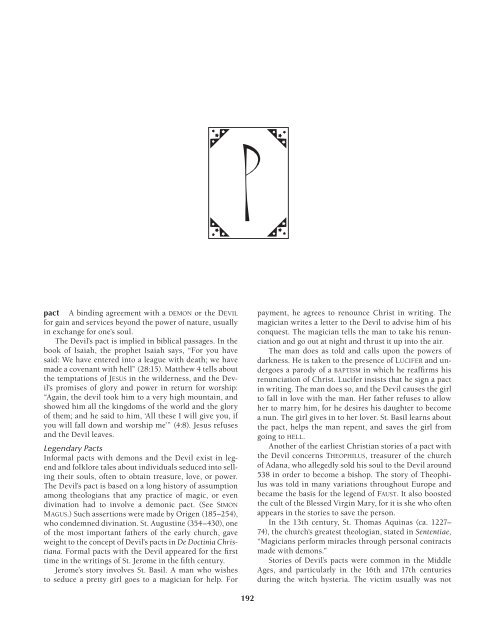The Encyclopedia Of Demons And Demonology
The Encyclopedia Of Demons And Demonology
The Encyclopedia Of Demons And Demonology
Create successful ePaper yourself
Turn your PDF publications into a flip-book with our unique Google optimized e-Paper software.
P<br />
pact A binding agreement with a DEMON or the DEVIL<br />
for gain and services beyond the power of nature, usually<br />
in exchange for one’s soul.<br />
<strong>The</strong> Devil’s pact is implied in biblical passages. In the<br />
book of Isaiah, the prophet Isaiah says, “For you have<br />
said: We have entered into a league with death; we have<br />
made a covenant with hell” (28:15). Matthew 4 tells about<br />
the temptations of JESUS in the wilderness, and the Devil’s<br />
promises of glory and power in return for worship:<br />
“Again, the devil took him to a very high mountain, and<br />
showed him all the kingdoms of the world and the glory<br />
of them; and he said to him, ‘All these I will give you, if<br />
you will fall down and worship me’ ” (4:8). Jesus refuses<br />
and the Devil leaves.<br />
Legendary Pacts<br />
Informal pacts with demons and the Devil exist in legend<br />
and folklore tales about individuals seduced into selling<br />
their souls, often to obtain treasure, love, or power.<br />
<strong>The</strong> Devil’s pact is based on a long history of assumption<br />
among theologians that any practice of magic, or even<br />
divination had to involve a demonic pact. (See SIMON<br />
MAGUS.) Such assertions were made by Origen (185–254),<br />
who condemned divination. St. Augustine (354–430), one<br />
of the most important fathers of the early church, gave<br />
weight to the concept of Devil’s pacts in De Doctinia Christiana.<br />
Formal pacts with the Devil appeared for the first<br />
time in the writings of St. Jerome in the fifth century.<br />
Jerome’s story involves St. Basil. A man who wishes<br />
to seduce a pretty girl goes to a magician for help. For<br />
payment, he agrees to renounce Christ in writing. <strong>The</strong><br />
magician writes a letter to the Devil to advise him of his<br />
conquest. <strong>The</strong> magician tells the man to take his renunciation<br />
and go out at night and thrust it up into the air.<br />
<strong>The</strong> man does as told and calls upon the powers of<br />
darkness. He is taken to the presence of LUCIFER and undergoes<br />
a parody of a BAPTISM in which he reaffirms his<br />
renunciation of Christ. Lucifer insists that he sign a pact<br />
in writing. <strong>The</strong> man does so, and the Devil causes the girl<br />
to fall in love with the man. Her father refuses to allow<br />
her to marry him, for he desires his daughter to become<br />
a nun. <strong>The</strong> girl gives in to her lover. St. Basil learns about<br />
the pact, helps the man repent, and saves the girl from<br />
going to HELL.<br />
Another of the earliest Christian stories of a pact with<br />
the Devil concerns THEOPHILUS, treasurer of the church<br />
of Adana, who allegedly sold his soul to the Devil around<br />
538 in order to become a bishop. <strong>The</strong> story of <strong>The</strong>ophilus<br />
was told in many variations throughout Europe and<br />
became the basis for the legend of FAUST. It also boosted<br />
the cult of the Blessed Virgin Mary, for it is she who often<br />
appears in the stories to save the person.<br />
In the 13th century, St. Thomas Aquinas (ca. 1227–<br />
74), the church’s greatest theologian, stated in Sententiae,<br />
“Magicians perform miracles through personal contracts<br />
made with demons.”<br />
Stories of Devil’s pacts were common in the Middle<br />
Ages, and particularly in the 16th and 17th centuries<br />
during the witch hysteria. <strong>The</strong> victim usually was not<br />
192












